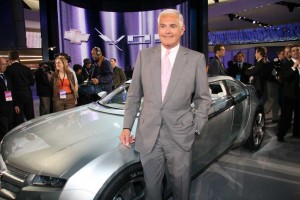
Lutz with the original Chevrolet Volt concept vehicle
For years, the auto industry’s biggest complaint about fuel economy standards was, “You can’t make us build cars our customers don’t want to buy.”
Of course, getting customers to buy their cars — or enough of them, anyway — has been a cause of Detroit 3 anxiety for some time, even when fuel economy pressure was minimal. Lutz’s job at GM was to put the passion back into the product, and at that he had some success even though larger forces were inexorably bearing down on the Detroit 3 and now the entire industry.
Announcing his retirement recently, Lutz remarked how he felt that his talents weren’t the right ones for the times, which bring much greater pressure to reshape cars for lower fuel consumption and CO2 emissions. In an AP interview, Lutz said that the new situation “doesn’t really play to my greatest skills, which were perhaps more in the intuitive, emotional area with sort of a sense for what the market would want.”
In reality, intense customer-oriented skills will be crucial more than ever. The difference is that they’ll have to be applied with a much different understanding of what the car can be about. It’s not Lutz’s talents that are passé; rather, it’s his attitudes about what’s important and what will come to be — indeed, is already starting to be — valued by a new generation of car buyers.
Lutz’s investment in the Chevy Volt and the public relations blitz that GM has built around it represent a glimmer of understanding on the part of the old guard that there might just be some emotional selling points around green. But it’s not clear that they’ve fully put two and two together.
Just a few years ago, even as it was becoming clear that that hybrids were seriously on the rise, there was much poo-pooing by Detroit leaders and many traditional auto scribes. The story lines were that hybrids didn’t make economic sense, that the technology was too expensive and would rarely pay for itself in terms of fuel savings. But cars have never been sold on the basis of cost-benefit analysis on the part of consumers. What marketeer expects the features they offer to provide consumers themselves with a pecuniary payback? Buyers will spend a lot more for emotional rewards.
Lutz himself had an “aha!” moment in 2005, when he was quoted as saying, “We forgot about the emotional impact and the fact that a lot of people out there want to make an environmental statement.”
It’s on that basis that new niches of opportunity can be constructed, and the techie toolbox is only part of the equation. The conventional wisdom is that it will take a lot of new technology to meet the upcoming environmental requirements. At GM, Lutz is being replaced with the company’s ultimate engineer, powertrain boss Thomas Stephens. As the Wall Street Journal writes, Stephens is “well-versed in what goes on under the hood, which is precisely where GM and other U.S. automakers have to play catch up with some foreign rivals.”
Unfortunately, what’s under the hood — green or otherwise — is less and less important to customers. That’s a hard insight for the gearhead culture to digest, and the horsepower wars will die hard even as they get consigned to smaller, ever-paunchier niches. Moreover, addressing the new challenge mainly with technology is the costly way to go about it. In contrast, pursuing automotive design packages creatively built around features other than mass and muscle can tap green-leaning sentiments (or at least not run afoul of them) while offering excitement in new and different ways.
Think Mini Cooper for example, which doesn’t feature green-branded technology but has been the right product for the present and, incidentally, helped BMW become the company that trimmed its fleet average CO2 emissions rate more than any other (even more than Toyota) over the past 15 years.
So, as Bob Lutz puts on his afterburners to blast one last exhaust stream over the sunset, one can only hope that a young man or woman — perhaps pierced and wired and purple haired — is working their way up the ranks of GM’s product planners to help the company create visceral products for new times.

good point on the mini cooper…but mr. lutz may have the last laugh on that one too. Seems the cadillac escalade hybrid (a lutz car that seats seven with lots of show) gets better gas mileage in the city than a mini cooper s. You are right that the industry needs a modern version of mr. lutz…someone not afraid of corporate brass, or afraid to push for passionate emotional design. As he often says, as the mpg, safety, warranty, quality of cars comes closer and closer — there is very little difference between manufacturers now — the last thing to distinguish cars and drive consumer purchases will be their styling and design. Time will tell if he was right…